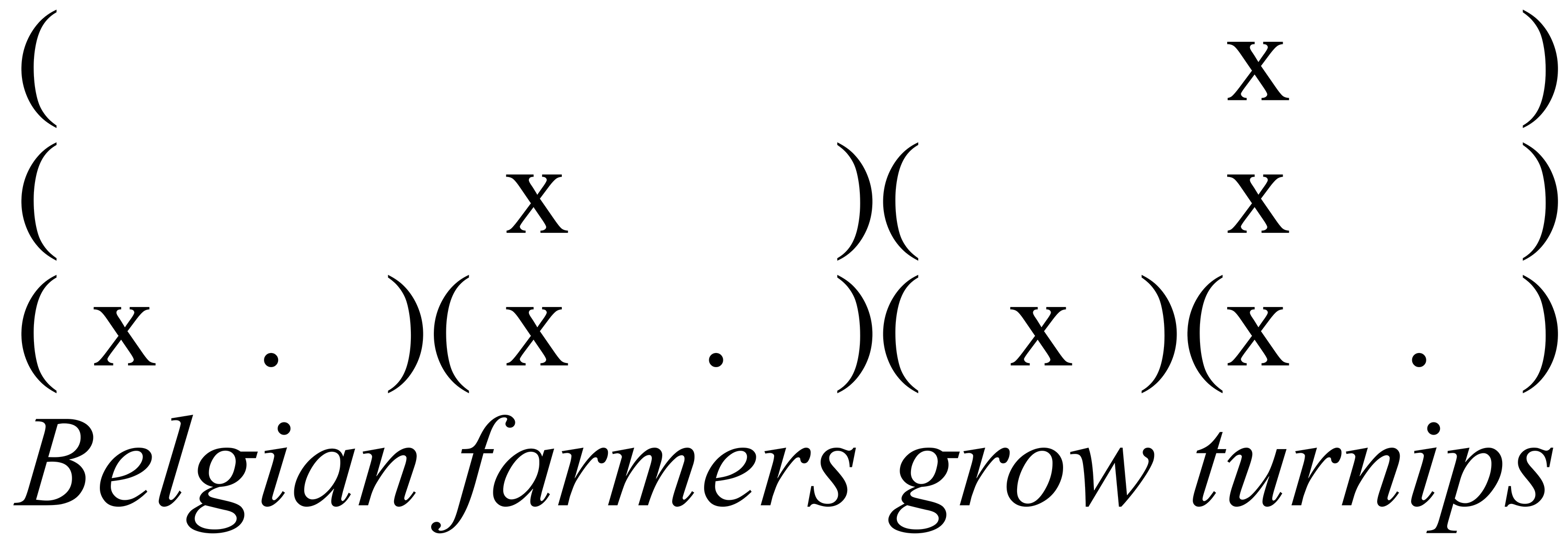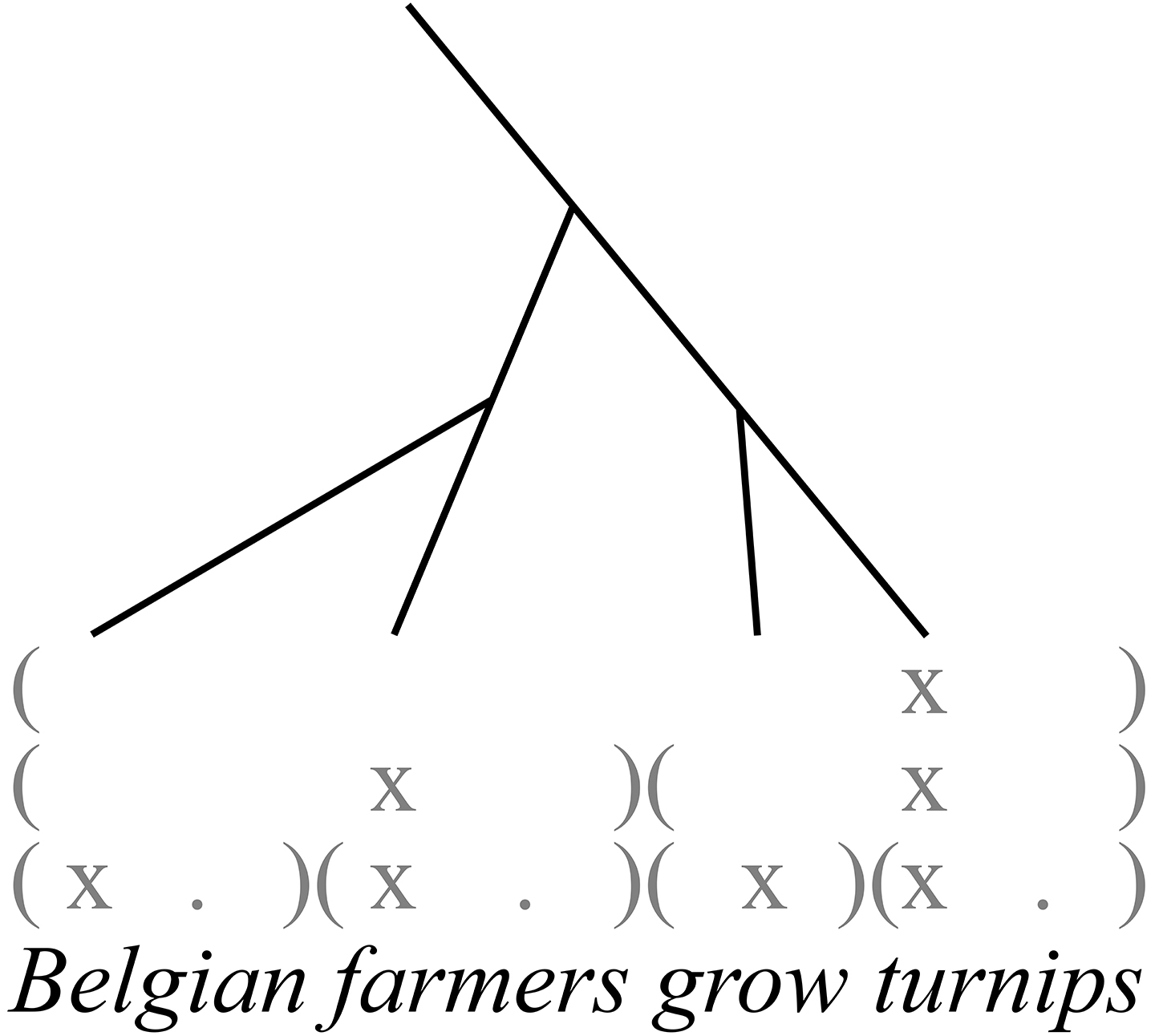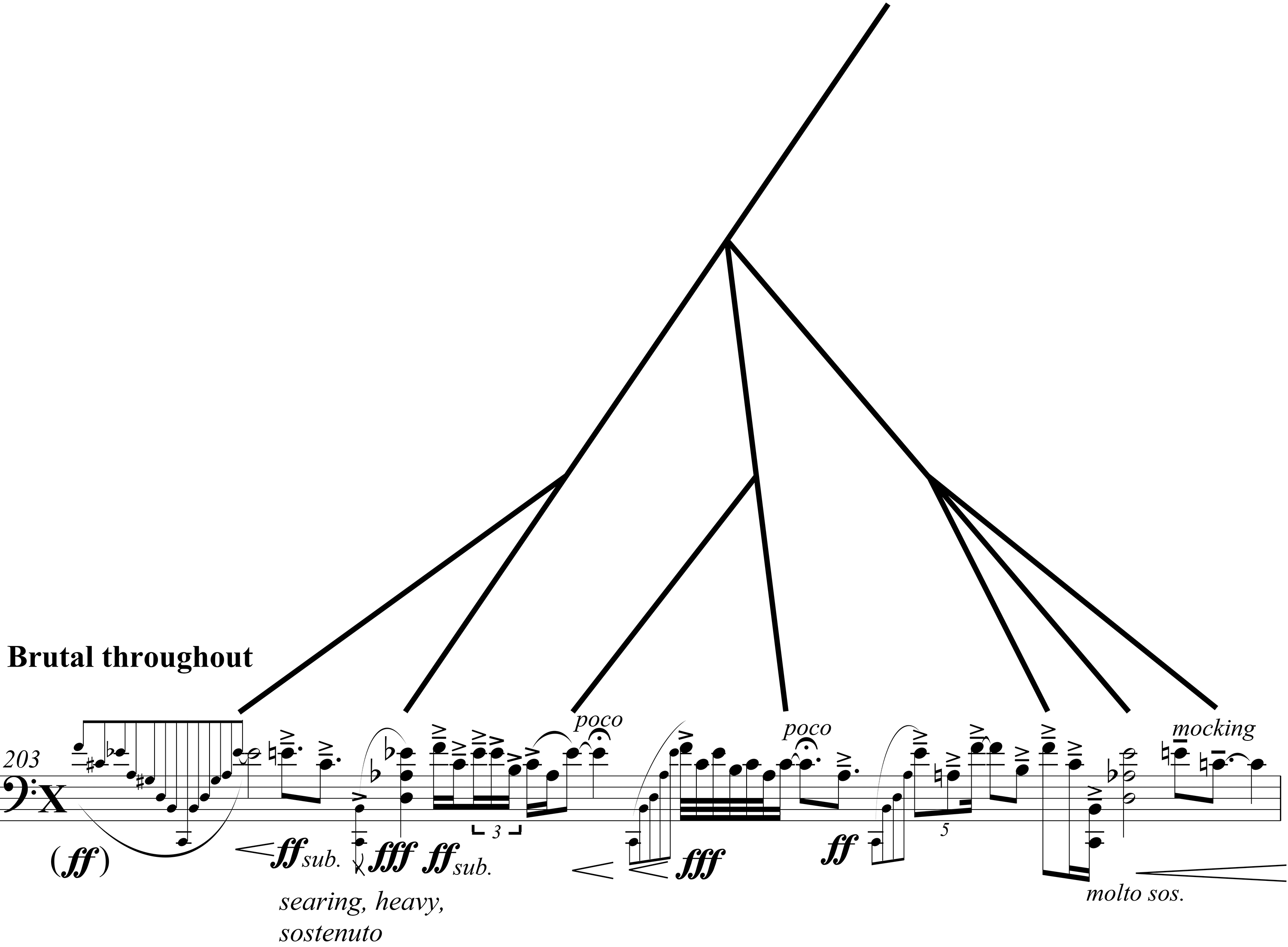Lee Hyla’s unique approach to music comes from influences that range from Ludwig van Beethoven and Elliott Carter to James Brown, Captain Beefheart, Neil Young, and Cecil Taylor. These artists were outliers in their own genres, and Hyla embraced the rhythmic intensity and strong gestures of their music to synthesize his unique approach to time. I theorize that listeners relate to Hyla’s musical phrases through underlying temporal structures that create a sense of regularity without evenness. I believe these same perceptual structures exist in language, which does not conform to an even rhythmic layout. As such, I analyze the temporal structure of Hyla’s music guided by linguistic stress theory.
Popular music, such as that of the rock and jazz performers who influenced Hyla, relies on performance practice and aural tradition to augment the score. Performers’ spontaneous temporal alterations are not notated, so any existing score serves as a template of the music instead of a representation of the final product. Hyla used conventional classical notation. His compositions do not rely on unwritten temporal alterations, but his music reflects the aesthetic associated with the spontaneous performative decision-making in the music of his influences. This results in highly detailed notation without an even meter or homogeneous rhythmic subdivisions, manifesting as meters changing frequently and subdivisions mixing together, such as triplets and quintuplets.
As an example of how popular music influenced Hyla’s compositions, I will discuss James Brown’s “The Popcorn” and Captain Beefheart’s Trout Mask Replica, both of which were very important to Hyla.
In much popular music, subdivisions of the beat can be played slightly early or delayed to give a song a particular feel. To achieve this feeling, Captain Beefheart taught the members of his band exactly how and when he wanted each sound to be placed by playing or singing the parts to them.1 The Most Ever Company has transcribed several songs from Trout Mask Replica, and their transcription of “Ella Guru” is reproduced in Example 1.2 The notated rhythmic subdivisions smaller than the quarter note are only eighths and sixteenths, which suggest a more even rhythmic execution than found in the original recording. By comparing the original recorded version, which was prepared with no notation, of the Guitar 2 part to the notated version, the third note of m. 2 is slightly early and the eighth notes in mm. 3 and 5 are played slower than precise eighth notes. These alterations, found in the recorded version, are especially striking because the uneven rhythms project a tension with a steady pulse perceived by listeners.

Various temporal characteristics of Beefheart are reflected in Hyla’s music, especially the “off-balance, propulsive tension typical of rock music.”3 Trout Mask Replica, Beefheart’s magnum opus, was produced by Frank Zappa who gave Beefheart complete artistic control of the album. Beefheart’s use of rhythm remains controversial ; Zappa commented that Beefheart avoided using an even pulse because he was unable to “make things happen on the beat,”4 but Andrew Norris suggests Beefheart “raises the spectre of a groove beyond the groove, a hypergroove perhaps to set alongside the etherealisations of a Morton Feldman.”5
Described as “one of the densest, strangest and most immediately off-putting records ever made,”6 Trout Mask Replica features speech-like vocals, instrumental lines with different time signatures, and words used for their sonic rather than semantic content. Several songs on the album involve instruments playing unaligned rhythms, and some of the tracks are comprised exclusively of speech. Beefheart’s music displays instruments independently placing rhythms slightly before or after the beat to create a loose alignment. The combination of the instruments’ differing interpretations of the beat creates a large-scale sense of time for the vocal line that resembles natural speech more than song. However, the listener senses a pulse emerging from the chaotic texture despite the nonalignment of the instruments.
As a testament to the importance of James Brown’s music Hyla kept a poster from the compilation Roots of a Revolution on his piano behind the pieces he was working on. Although sources disagree about whether or not Brown invented the funk style,7 he certainly “melded it into a cohesive, rhythmically locked musical structure.”8 Brown wrote, “I had discovered my strength was not in the horns, it was in the rhythm,”9 and that strength manifested itself as “complex, out-front, crack, rhythmic arrangements.”10 The 1969 song “The Popcorn” was one of Hyla’s favorites11 and contains typical features of the style : steady pulse maintained by the drums, active but fragmented bass guitar, staccato horn interjections, and syncopated melodic instruments with pointed articulation. After 1965, Brown’s music “seems improvisational even when the groove is very tightly knit, completely orchestrated.”12 The relationship of the rhythmic independence in the melody to the steady metrical pulse creates a driving tension, foregrounding a “more active, aggressive style of drumming” that emphasized the downbeat of rhythmic patterns followed by “a flurry of syncopated activity in the latter part of the pattern.”13 A characteristic feature of funk music is that “melodic lines are often created by rhythm instruments,”14 and Hyla’s music often blurs this same division between the two roles. (We Speak Etruscan is a great example of this.) Brown’s influence is reflected in the timbre, but also in the rhythmic tension.
The complexity of Hyla’s notation obscures the rhythmic feel of his influences, but there are underlying structures reflecting a similar conception of time. Because standard metric and rhythmic notation cannot communicate the specificity of rhythmic placement in his music, Hyla uses dense, uneven, and irregular rhythms, written as combinations of various subdivisions of the notated meters. Also, his nonclassical influences include performance traditions that rely on interpretive performative alterations to rhythm. An example is the concept of “swinging” in which consecutive eighth notes are performed unevenly, and the degree of unevenness depends on the context and the performer. Hyla’s music specifically captures and notates such temporal alterations and allows them to be free of an even meter.
Gil Rose, conductor of the Boston Modern Orchestra Project, has said of Hyla’s music : “Focusing on gesture seems to get you precision, not the other way around.”15 Gesture is central to Hyla’s approach to time as related to phrasing and structure, and his notation molds to each gesture regardless of its unevenness or complexity. But the term “gesture” carries a wide range of definitions and connotations. Most commonly, discussion of the term begins with physical movement, and the structure of musical gestures is understood to rely on physicality.16 Such physical motions are intended to communicate information and feeling, ranging from gestures that are innately understood17 to others that have evolved to be dependent upon the “social interactive context.”18 For instance, a smile might be widely recognized as a signal of happiness or approval, whereas a rude gesture in one country would be meaningless to someone unfamiliar with that culture. A sense of gesture is fundamental to the human experience and to interaction between people, as seen ubiquitously in communication between people who do not speak a common language. In an effort to be understood, physical motions replace words, such as pointing at subway stops on maps, and varying the speed of movement suggests different affects. Gestures add information to words but can also function in place of them.
According to Joel Lester, “Without the perceptual metric grid synchronized with the sounding music, the sense in which some events anticipate the beat, are suspended past the beat, or arrive on the beat is irrelevant.”19 Hyla’s music, however, posits gesture as an alternative organizing factor. The examples that make up my framework for this argument come from sections without a perceptible pulse (even though some sections of Hyla’s music do have a steady, periodic beat). These passages, as a result of meter changes, additive meters such as 2/4 + 1/8, rubato, and free tempo, do not have an even perceptible pulse. The rhythms are often offset from the metric beats, further obscuring the underlying meter even though events are notated within a metric framework.
Listeners perceive temporal structure according to different perceptual markers in Hyla’s music due to its lack of a steady beat. In order to understand and analyze this temporal tension and phrasing, I have developed an analytical framework based on the combination of Lerdahl and Jackendoff’s A Generative Theory of Tonal Music20 (GTTM) with Bruce Hayes’s metrical stress theory from linguistics. GTTM was published in 1983 and describes perception of heard structures through the use of Noam Chomsky’s generative linguistic theory, analyzing the heard structure of music according to rules of grouping and meter. GTTM relies on even meter, so the theory must be extended beyond the assumptions of periodic meter and the traditional beat hierarchy in order to analyze Hyla’s music. Metrical stress theory, however, can aid in analyzing music without a constant, evenly spaced beat because linguistic stress operates hierarchically without a periodic framework. Hayes’s theory, published in 1995, suggests stress in language manifests as linguistic rhythm, and I use it in my framework to extend the limits of GTTM.
Speaking was involved in Hyla’s musical process, and I equate the “speech-like” quality of Hyla’s music to its uneven rhythmic values and infrequent repetition. My recent research in Hyla’s archive in Chicago revealed several cassette tapes he used while composing that contain audio of him working out his music vocally. He would record himself playing the piano and sometimes vocalizing, and then he would record himself a second time playing and vocalizing over the first recording.
Languages are classified as rhythmically organizing around either stress or syllables. Languages such as English, Norwegian, Russian, and Arabic, organize around stresses, meaning that syllables vary greatly in length, and are termed stress-timed languages. Others, such as French, Italian, Finnish, and Turkish are spoken with each syllable lasting roughly the same amount of time and are termed syllable-timed languages. This can be measured with the normalized pairwise variability index (nPVI), which measures durational variability. For example, a sequence of quarter notes with one eighth note will have a low durational variability as compared to a combination of many different lengths of notes.
Aniruddh Patel and Joseph Daniele found that the rhythm of a composer’s language is reflected in the rhythm of his or her music. Using the Barlow & Morgenstern Dictionary of Musical Themes for source material, their study included all composers who were born in the 1800s and died in the 1900s and who were native speakers of British English or French who lived and worked in their home country. English speech has a higher durational variability than French, which makes sense given that English is stress-timed and French is syllable-timed. This relationship was reflected in the comparison between English and French music. They also excluded music that used words or purposefully reflected a cultural style, and this test was successfully replicated with many more composers and languages by David Huron and Joy Ollen. Example 221 shows the graphs resulting from Patel and Daniele’s original experiment that prove a connection between rhythm in a composer’s language and music.
In language, perceptual prominence is analyzed as stress. The primary perceptual markers of stress are pitch contour, duration, and loudness ; pitches that are relatively high or low, long, or loud are perceived as more stressed. Example 3 displays an example from Hayes’s book. Stress is assigned to each syllable according to lexical rules, grammar, and sentence structure. Each syllable receives a dot or X, with the Xs representing relative levels of stress, and groups are enclosed within parentheses at each hierarchical level. For instance, at the lowest level, “Belgian” is grouped as a word with the first syllable receiving the greatest stress. At the second level, “Belgian farmers” is a phrase, and the noun “farmer” receives greater stress than its modifying adjective “Belgian.” This analysis describes the heard structure.



This notation can be translated into a tree diagram, shown in Example 4. The level of emphasis corresponds to the height of the line. Thus, the syllable with three Xs is connected to the tallest line. The syllable with two Xs connects to the line at the second-highest level, and so forth.
Similarly, the tree diagram can show the underlying temporal structure in music. I have developed a set of rules, based on perception and inspired by GTTM and metrical stress theory, that guide analyses to show the heard structure. For instance, the rules rely on the three perceptual indicators of stress previously mentioned : pitch contour, duration, and loudness. Without getting into the plethora of other details and conditions, Example 5 shows an analysis of an excerpt from Dream of Innocent III (DOI3). The piece is scored for amplified cello, piano, and percussion, and was inspired by a Giotto fresco depicting Pope Innocent III dreaming that St. Francis is literally holding up the Catholic church on his shoulder. The piece is structured in three sections with two intervening cello solos, and the following excerpt is taken from the beginning of the second cello solo.
My analysis incorporates the sense of gesture coming from Hyla’s performer-centric influences. For instance, the opening grace notes slurred to the half note E-flat are contained within a single gesture. The most perceptually prominent note in the gesture is the final E-flat because it has the longest duration and sits at the outer edge of the pitch contour of the gesture. The precise tempo and shape of the grace notes are at the discretion of the performer, which allows for different nuances between performances. Although rhythm is the foundation of my analysis, pitch is a factor as well, exemplified in this gesture because E-flat is a salient pitch throughout the cello solo as a whole.
My analyses provide a hierarchical map of phrasing by outlining the heard structure based on my understanding of the construction of the music, just as the stress analysis of Example 3 was generated from grammatical rules for the sentence.
By examining Hyla’s music through the lens of linguistic stress, I show how listeners perceive clear temporal constructions without an even or periodic meter. Hyla’s music displays underlying regularity without evenness that comes from a deep connection to his influences, and listeners are able to relate and compare phrases based on the underlying temporal structures. Phrasing in Hyla’s music is directly linked to temporal perception, which is described in linguistics as stress. For a detailed explanation of my analytical process, see my Ph.D. dissertation titled “A Linguistic Approach to Rhythm and Meter : Analysis of Temporal Structure and Phrasing in the Music of Lee Hyla.” Through understanding the heard structure, performers can conceive of phrasing in Hyla’s music guided by rhythm. I have not yet applied these concepts to other repertoire, but I believe the connections between language and Hyla’s music that inspired my analyses are widely applicable.

Example 5: DOI3, m. 203 with tree analysis
1 The Artist Formerly Known as Captain Beefheart, directed by Elaine Shepard (UK : BBC, 1997).
2 TMEC Rep, “Captain Beefheart | Ella Guru [transcription],” YouTube video, 2 :20, Posted [Sep 23, 2015], https://www.youtube.com/watch?v=6tCLPL8otMM.
3 Walter Everett, The Foundations of Rock : From “Blue Suede Shoes” to “Suite : Judy Blue Eyes” (New York : Oxford University Press, 2009), 8.
4 Mike Barnes, Captain Beefheart (London : Quartet Books, 2000), 218.
5 Andrew Norris, “Projections of the Pulseless Body : Don van Vliet and Henri Chopin,” Chapter & Verse no. 3 (Spring 2005).
6 Tim Page, “O Captain ! Beefheart’s Enduring Offbeat Legacy,” The Washington Post, 12 December 1999.
7 Jennifer Lena, Banding Together : How Communities Create Genres in Popular Music (Princeton, NJ : Princeton University Press, 2012) ; Martin Munro, Different Drummers : Rhythm and Race in the Americas (Berkeley : University of California Press, 2010)
8 Alexander Stewart, “ ‘Funky Drummer’ : New Orleans, James Brown and the Rhythmic Transformation of American Popular Music,” Popular Music 19, no. 3 (2000) : 309.
9 James Brown and Bruce Tucker, James Brown : The Godfather of Soul (New York : Macmillan, 1986), 158.
10 Robert Bowman, “Brown, James (1933–2006) Soul Music Singer,” In The New Encyclopedia of Southern Culture : Volume 12 : Music, edited by Bill C. Malone (Chapel Hill, NC : University of North Carolina Press, 2008), 188
11 According to Katherine Desjardins
12 Steven F. Pond, “ ‘Chameleon’ Meets ‘Soul Train’ : Herbie, James, Michael, Damita Jo, and Jazz-Funk,” American Studies 52, no. 4, THE FUNK ISSUE (2013) : 133.
13 Stewart, “Make It Funky : Fela Kuti, James Brown and the Invention of Afrobeat,” 106–107.
14 Jennifer Lena, Banding Together : How Communities Create Genres in Popular Music (Princeton, NJ : Princeton University Press, 2012), 79.
15 Theodore Mook, liner notes to Trans, Boston Modern Orchestra Project, New World Records 80614, CD, 2004.
16 Rolf Inge Godøy and Marc Leman, eds., Musical Gestures : Sound, Movement, and Meaning (London : Routledge, 2009).
17 Colwyn Trevarthen, Jonathan Delafield-Butt, and Benjaman Schögler, “Psychobiology of Musical Gesture : Innate Rhythm, Harmony and Melody in Movements of Narration,” In New Perspectives on Music and Gesture, edited by Elaine King and Anthony Gritten, 11–44 (Abingdon : Routledge, 2011), 21.
18 David McNeill, Language and Gesture (New York : Cambridge University Press, 2000), 12.
19 Lester, “Notated and Heard Meter,” 122.
20 Fred Lerdahl and Ray Jackendoff, A Generative Theory of Tonal Music (Cambridge, MA : MIT Press, 1983).
21 Patel and Daniele, “An empirical comparison of rhythm in language and music,” Cognition. 2003 Feb ; 87(1) B38 and B41.